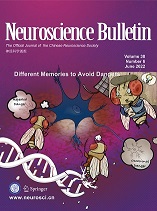A Deep Mesencephalic Nucleus Circuit Regulates Licking Behavior
Di Zheng1,2 • Jia-Yu Fu1,2 • Meng-Yu Tang1,2 • Xiao-Dan Yu1,2 • Yi Zhu1,2 •
Chen-Jie Shen2 • Chun-Yue Li1,2 • Shi-Ze Xie1,2 • Shan Lin1,2 • Minmin Luo3,4,5 •
Xiao-Ming Li1,2,6
2022, 38(6): 565-575 [
Abstract] [
SpringerLink]
[PDF]
Whole-Brain Direct Inputs to and Axonal Projections from Excitatory and Inhibitory Neurons in the Mouse Primary Auditory Area
Mengting Zhao1 • Miao Ren2 • Tao Jiang3 • Xueyan Jia3 • Xiaojun Wang2 •
Anan Li1,3 • Xiangning Li1,3 • Qingming Luo2 • Hui Gong1,3
2022, 38(6): 576-590 [
Abstract] [
SpringerLink]
[PDF]
Astrocytic Gap Junctions Contribute to Aberrant Neuronal Synchronization in a Mouse Model of MeCP2 Duplication Syndrome
Shengnan Xia1,2 • Hua-Tai Xu1,3
2022, 38(6): 591-606 [
Abstract] [
SpringerLink]
[PDF]
The SACT Template: A Human Brain Diffusion Tensor Template for School-age Children
Congying Chu1,7 • Haoran Guan1 • Sangma Xie8 • Yanpei Wang1 •
Jie Luo1 • Gai Zhao1 • Zhiying Pan1 • Mingming Hu1 • Weiwei Men3,4 •
Shuping Tan6 • Jia-Hong Gao3,4,5 • Shaozheng Qin1,2 • Yong He1,2 •
Lingzhong Fan9 • Qi Dong1 • Sha Tao1
2022, 38(6): 607-621 [
Abstract] [
SpringerLink]
[PDF]
Signaling Mechanism for Modulation by GLP-1 and Exendin-4 of GABA Receptors on Rat Retinal Ganglion Cells
Tao Zhang1 • Hang-Ze Ruan1 • Yong-Chen Wang1 • Yu-Qi Shao1 •
Wei Zhou1 • Shi-Jun Weng1 • Yong-Mei Zhong1
2022, 38(6): 622-636 [
Abstract] [
SpringerLink]
[PDF]
Chaperone-mediated Autophagy Regulates Cell Growth by Targeting SMAD3 in Glioma
Hanqun Liu1 • Yuxuan Yong3 • Xingjian Li1 • Panghai Ye1 • Kai Tao2 •
Guoyou Peng1 • Mingshu Mo1 • Wenyuan Guo1 • Xiang Chen1 • Yangfu Luo1 •
Yuwan Lin1 • Jiewen Qiu2 • Zhiling Zhang1 • Liuyan Ding1 • Miaomiao Zhou1 •
Xinling Yang3 • Lin Lu1 • Qian Yang4 • Pingyi Xu1
2022, 38(6): 637-651 [
Abstract] [
SpringerLink]
[PDF]
VPS35 Protects Against TMEM230-mutation-induced Progressive Locomotor Deficits in Drosophila
Chao Ma1 • Xiaobo Wang1,2 • Wanli W. Smith2 • Zhaohui Liu1
2022, 38(6): 652-656 [
Abstract] [
SpringerLink]
[PDF]
Exclusion and Co-expression of Aversive Olfactory Long-Term Memories in Drosophila
Bohan Zhao1,2,3 • Xuchen Zhang1,2,4 • Jianjian Zhao1,2 • Qian Li1,2
2022, 38(6): 657-660 [
Abstract] [
SpringerLink]
[PDF]
An Easily Compatible Eye-tracking System for Freely-moving Small Animals
Kang Huang1,2 • Qin Yang1 • Yaning Han1,2 • Yulin Zhang1 • Zhiyi Wang3 •
Liping Wang1,2 • Pengfei Wei1,2
2022, 38(6): 661-676 [
Abstract] [
SpringerLink]
[PDF]
Biofluid Biomarkers of Alzheimer’s Disease: Progress, Problems, and Perspectives
Shan Huang1 • Yan-Jiang Wang2 • Junhong Guo1
2022, 38(6): 677-691 [
Abstract] [
SpringerLink]
[PDF]
Epigenetic Mechanism of Depression after Early Life Stress
Xin Li1 • Tian-Ming Gao1
2022, 38(6): 692-694 [
Abstract] [
SpringerLink]
[PDF]
Microglia Share the Burden
Qian Wang1,2 • Xiumin Xue1,2 • Zhihui Huang1,2 • Yongjie Wang1,2
2022, 38(6): 695-698 [
Abstract] [
SpringerLink]
[PDF]
Astrocyte-Derived Saturated Lipids Mediate Cell Toxicity in the Central Nervous System
Yiming Qian1,2 • Mengmeng Wang1,2 • Jianhong Dong1,2 • Yuanyuan Jiang1,2 •
Zhihui Huang1,2
2022, 38(6): 699-702 [
Abstract] [
SpringerLink]
[PDF]

Animals, including fruit flies, often require repeated training to form long-term memories (LTMs). Recently, researchers have found that two new types of LTM are formed in fruit flies after a single aversive olfactory training trial. Zhao et al. systematically investigated the relationship between these LTMs and proposed that animals can organize different LTMs to avoid occasional and repeated dangers in the natural environment. In the cover image, the cartoon fruit fly in the upper right corner has to face occasional and repeated dangers. These different types of LTM compete and cooperate to help the fly guide its behavior to better adapt to the environment. See pages 657–660. (Cover designed by Dr. Bohan Zhao and Hefei Chuangtao Cultural Creativity Co., Ltd).